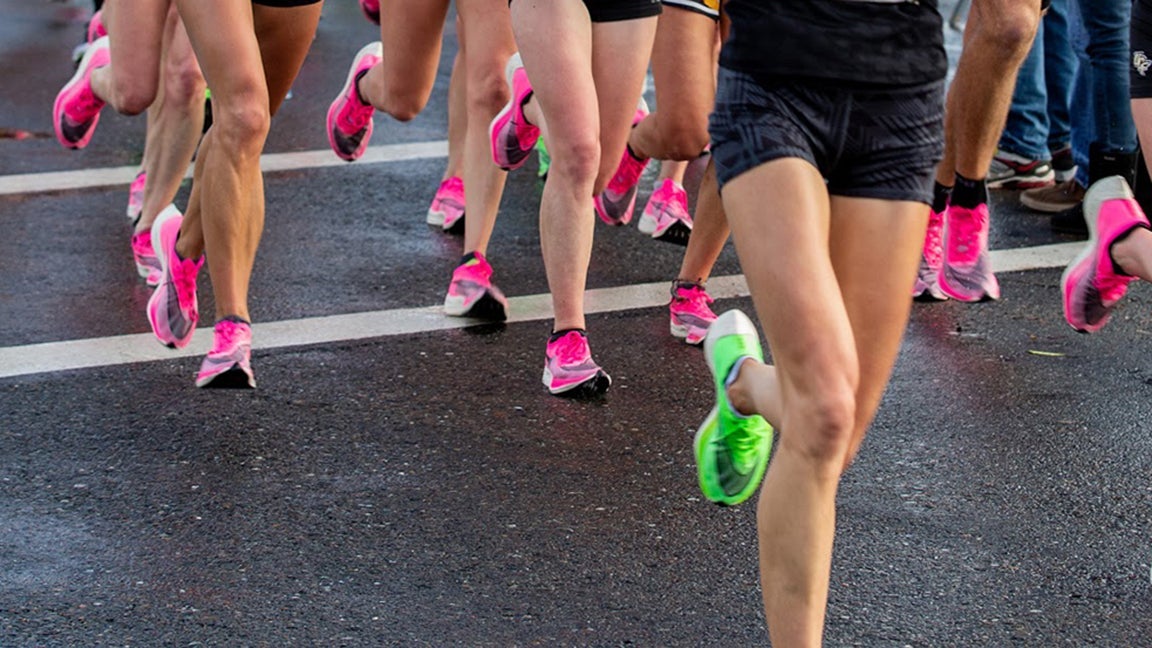A new analysis of the last 10 years of results from four World Marathon Majors races adds much evidence to the idea that super shoes produce faster times. The study, released Jan. 2, also shines a light on an important new wrinkle: Women may benefit more than men.
This isn’t actually a sex-based finding, but it nonethless impacts race results and marathon statistics, which are of course grouped by male/female categories. See below for more discussion of this effect.
A research group including well-known marathon experts Andy Jones and Michael Joyner, along with Sandra Hunter, a frequent Joyner collaborator on sex-based studies, wanted to see if elite marathon times improved dramatically in 2019. That was the first year that Nike’s Vaporfly 4% were widely available. To do this, they collected results from the top 50 male and female finishers at the Boston, London, Chicago, and New York City Marathons from 2010 through 2019.
This gave them 3900 data points, as there was no NYC Marathon in 2012, due to Hurricane Sandy. Remarkably, they were able to identify the shoes worn by 3886 of the 3900 runners.
Stable Results, Then a Spike
The results showed a strong stability of performance through 2018. Runners apparently weren’t training harder or more efficiently, developing new genes, or racing in faster shoes. The top 50 men in the four marathons had an average time of 2:21:18. The top 50 women had an average time of 2:43:24.
Then came 2019, and the average top 50 times dropped to 2:18:30 and 2:39:06. This represented a 2 percent improvement for men, and a 2.6 percent improvement for women.
More tellingly, the researchers were able to do a subset analysis of runners completing the same marathon in 2018 and 2019 — first in a non Nike shoe, then in a Nike shoe (in 2019). In other words, the runners switched from a traditional racing flat to a new Nike super shoe, but raced the same course. This review picked up 239 runners, including 101 women.
The men got faster by 1:12, and the women by 3:42. These improvements represented percentage gains of 0.8% and 1.6 percent.

Speed, Not Sex
Why do super shoes benefit women more than men? No one can say for sure, but exercise physiology researcher Shalaya Kipp (also a U.S. Olympic steeplechaser at the 2012 Olympics) looked into this question several years ago while studying at the University of Colorado. She found two theoretical reasons why slower runners might gain more from super shoes: one related to a connection between running economy and oxygen consumption; the other to the well-established fact that faster-moving objects (cars, cyclists, even runners) encounter more air resistance than slower objects.
“As an individual runs faster, the energy cost of overcoming air resistance increases more than proportionally — proportional to velocity cubed to be exact,” explains Kipp, who’s currently completing her PhD at the University of British Columbia. “It is likely that women are benefiting more from the same percentage improvement in running economy as men (about 4% if they’re in a Vaporfly) since they run at slightly slower speeds.”
Thus it’s not your sex that gives you more gain from the new shoes. It’s simply your average pace before you slip on the shoes. Slower men would get a bigger boost from the shoes than faster men. Since elite women are about 10 percent slower than elite men, they gain more than elite men. A New York Times big-data dive into the Nike shoes also revealed that slower runners improved slightly more than faster runners.
When Eliud Kipchoge in Vienna in October, 2019, his performance produced worldwide headlines because he broke an “impossible barrier”— the sub-2-hour mark. However, mere hours later in Chicago, Brigid Kosgei ran a world-record 2:14:04 that impressed many running fans even more than Kipchoge’s effort. Since Paula Radcliffe’s previous record, 2:15:25, set in 2003, had long seemed untouchable, Kosgei’s race alerted the running world to the coming wave of fast women.
Over the last two years, running in new Asics super shoes, U.S. marathon star Sara Hall, 37, has improved from a 2:26:20 to 2:20:32 marathoner. That’s a leap forward of about 4 percent for Hall.

Your Stride Matters
Other runners, both male and female, are making similar improvements in new Nike-like models from Adidas, Saucony, Hoka, and other companies. Research has shown that there is a substantial “range” of performance improvement among runners in the new shoes. That is, some runners improve more than others, depending on their individual stride characteristics and other factors.
The new report on the four Marathon Majors largely agrees with what other investigators, including Nike researchers, have found in laboratory trials. Yes, the super shoes might improve running economy by up to 4 percent, hence the name of the Nike’s Vaporfly 4%. But that’s not the same as saying you’ll run four percent faster. Most studies have rated the speed improvement at 1 to 2.5 percent.
It is, however, more than enough to get runners to lace up the new footwear. In the last Marathon Major investigated — the Nov, 2019 NYC Marathon — fully 70 percent of elite athletes were running in Nike super shoes.
According to the new paper, there are three likely reasons why the new shoes are faster than earlier racing shoes: (1) curved carbon-fiber plates; (2) a lighter and more responsive midsole material; and (3) thicker midsoles. The researchers conclude: “Our findings indicate that the approximately four percent reduced energetic cost of running observed in laboratory settings translates to real, but lesser, improvements in real world racing conditions.”
Their report has not yet been peer-reviewed or published by a traditional scientific journal. It is available as a free, full-text document here at a prepress aggregator named “medRxiv” entitled “” This does not mean the research is weak or insignificant. It merely indicates that the authors wanted to share their findings as quickly as possible and it has yet to be thoroughly evaluated.


